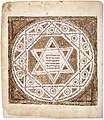Woes of the Pharisees: Difference between revisions
Undid revision 266460405 by Intelligentlove (talk)removed illustrations copied from elsewhere...take to talk page |
Please leave the graphics or (pictures) of the pharisees in the article ...Thank you |
||
| Line 1: | Line 1: | ||
{{nofootnotes}} |
{{nofootnotes}} |
||
[[Image:Book_of_Luke.jpg|thumb|right|148px]] |
[[Image:Book_of_Luke.jpg|thumb|right|148px|<center>[[Book of Luke]]]] |
||
{{Gospel Jesus}} |
{{Gospel Jesus}} |
||
The '''Woes of the Pharisees''' is a list of criticisms by [[Jesus]] against [[Scribes]] and [[Pharisees]] and [[Lawyers]] that is present in the [[Gospel of Luke]] {{bibleverse-nb||Luke|11:37-54}} and [[Gospel of Matthew]] {{bibleverse-nb||Matt|23:1-36}}. Seven are listed in Matthew, and hence Matthew's version is known as '''the seven woes''', while only six are given in Luke, whose version is thus known as '''the six woes'''. They do not occur in the same point of the narrative, in Matthew they occur shortly before Jesus returns to Jerusalem for his last few days before being crucified, while in Luke they occur shortly after the [[Lord's prayer]] is given and the [[Disciple (Christianity)|disciples]] are first sent out over the land. Since they occur in Luke and Matthew but not the [[Gospel of Mark]], and in different positions of the narrative, they are considered likely to derive from an earlier [[Q document]]. |
The '''Woes of the Pharisees''' is a list of criticisms by [[Jesus]] against [[Scribes]] and [[Pharisees]] and [[Lawyers]] that is present in the [[Gospel of Luke]] {{bibleverse-nb||Luke|11:37-54}} and [[Gospel of Matthew]] {{bibleverse-nb||Matt|23:1-36}}. Seven are listed in Matthew, and hence Matthew's version is known as '''the seven woes''', while only six are given in Luke, whose version is thus known as '''the six woes'''. They do not occur in the same point of the narrative, in Matthew they occur shortly before Jesus returns to Jerusalem for his last few days before being crucified, while in Luke they occur shortly after the [[Lord's prayer]] is given and the [[Disciple (Christianity)|disciples]] are first sent out over the land. Since they occur in Luke and Matthew but not the [[Gospel of Mark]], and in different positions of the narrative, they are considered likely to derive from an earlier [[Q document]]. |
||
| Line 18: | Line 18: | ||
==See also== |
==See also== |
||
[[The Law of Christ]]. |
[[The Law of Christ]]. |
||
== Pharisees == |
|||
<center><gallery> |
|||
<!-- Unsourced image removed: Image:Patchogue Pineneck Boat Ramp.JPG|<center><center> --> |
|||
Image:Pharisee.jpg|<center></center> |
|||
Image:Leningrad_Codex_Carpet_page_e.jpg|<center></center> |
|||
Image:Woe_to_you.jpg|<center></center> |
|||
</gallery></center> |
|||
Revision as of 03:46, 30 January 2009
This article includes a list of references, related reading, or external links, but its sources remain unclear because it lacks inline citations. |
| Events in the |
| Life of Jesus according to the canonical gospels |
|---|
 |
|
Portals: |
The Woes of the Pharisees is a list of criticisms by Jesus against Scribes and Pharisees and Lawyers that is present in the Gospel of Luke 11:37–54 and Gospel of Matthew 23:1–36. Seven are listed in Matthew, and hence Matthew's version is known as the seven woes, while only six are given in Luke, whose version is thus known as the six woes. They do not occur in the same point of the narrative, in Matthew they occur shortly before Jesus returns to Jerusalem for his last few days before being crucified, while in Luke they occur shortly after the Lord's prayer is given and the disciples are first sent out over the land. Since they occur in Luke and Matthew but not the Gospel of Mark, and in different positions of the narrative, they are considered likely to derive from an earlier Q document. The woes mostly criticise the Pharisees for hypocrisy and perjury. Before introducing the woes themselves, Matthew states that Jesus criticised them for taking the place of honour at banquets, for wearing ostentatious clothing, for encouraging people to call them Rabbi.
The woes
The woes themselves are the following criticisms:
- Shutting the kingdom of heaven in men's faces. (Mat. 23:13-14)
- Making converts twice as much a son of hell as the converters themselves are. (Mat. 23:15)
- Claiming that swearing by the temple is nothing, but claiming that swearing by the temple's gold is everything. (Mat. 23:16-22)
- Obeying the minutiae of the law (such as giving up a tithe) but neglecting the important facets (such as justice, and mercy) - metaphorically straining out a gnat but swallowing a camel. (Mat. 23:23-24)
- Being shallow - metaphorically cleaning the outside of the cup and dish but leaving the inside full of greed and self-indulgence. (Mat. 23:25-26)
- Hypocrisy - appearing righteous but actually being full of wickedness, metaphorically like whitewashed tombs, beautiful on the outside, but full of dead men's bones. (Mat. 23:23-27)
- Claiming that they would have behaved better than their forefathers - even though they build and respect the tombs of those who murdered the prophets. (Mat. 23:29-36)
]The gospel writer of Matthew precedes the woes with a discussion of the great commandment (or two greatest commandments See also Ministry of Jesus:General Ethics). The woes can be seen as the consequence of violating these commandments, and of neglecting them in favor of the minor observances of the law. Jesus is portrayed as impatient with outward, ritual observance of minutiae which made some of his critics look acceptable and virtuous outwardly but left the inner person unreformed. This type of religious behavior neglected to help those in need--"They tie up heavy loads and put them on men's shouders, but they themselves are not willing to lift a finger to move them.
See also
Pharisees

